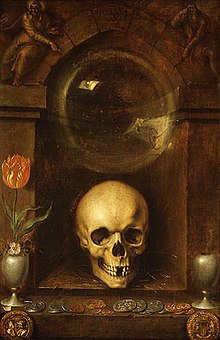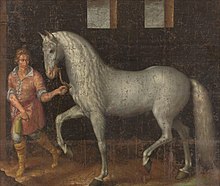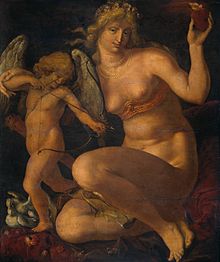Jacob de Gheyn II
Jacob de Gheyn II. Or Jacques de Gheyn II. (* Around 1565 in Antwerp , † March 29, 1629 in The Hague ) was a Dutch painter and engraver .
Life
De Gheyn was initially trained by his father, the glass painter , engraver and draftsman Jacob de Gheyn I. In 1585 he moved to Haarlem and studied with Hendrik Goltzius for five years. In 1590/91 he stayed in Amsterdam . In the mid-1590s he moved to Leiden . De Gheyn worked mainly with copperplate engravings until 1600 , but from then on turned to etching . In 1605 he moved to The Hague and was commissioned by the Dutch Crown to create a garden in the Buitenhof for Prince Moritz of Orange ; this is where the first artificial grottos in the Netherlands were built. When the prince died in 1625, de Gheyn worked for his brother Friedrich Heinrich .
De Gheyn was one of the first Dutch people to paint nudes , still lifes and vanitas motifs. He made over 1,500 drawings , including landscapes and animals .
De Gheyn married Eva Stalpaert van der Wiele from Mechelen in 1595. Their son, Jacob de Gheyn III, was born in 1596 and also became an engraver.
Museum reception
The permanent exhibition in the Army History Museum in Vienna contains rotating picture stands containing a large number of copper engravings by de Gheyn. The engravings come from the work “Arms dealership of the tubes, musquettes and skewers” , a manual for the handling of early firearms that was created in The Hague . Since the soldier of the 17th century was generally illiterate , he had to be taught how to use the light hand pipe , the heavy musket and the pike using pictures.
Works (excerpt)
- Neptune and Amphitrite , oil on canvas, 103.5 × 137, Wallraf-Richartz-Museum & Fondation Corboud , Cologne
- Spanish warhorse , 1603, oil on canvas, 228 × 269 cm, Rijksmuseum Amsterdam , Amsterdam
- Vanitas , 1603, oil on panel, 32.5 × 21.5 cm, Metropolitan Museum of Art , New York
- Venus and Cupid , 1605/10, oil on panel, 132 × 112 cm, Rijksmuseum Amsterdam, Amsterdam
- Flower Vase with Curtain , 1615, oil on panel, Kimbell Art Museum
literature
- Adolphe Siret: Gheyn, Jakob Jansz van . In: Allgemeine Deutsche Biographie (ADB). Volume 9, Duncker & Humblot, Leipzig 1879, p. 143.
Web links
Individual evidence
- ↑ www.artnet.com: Gheyn, de . (2000). The Grove Dictionary of Art as of 2007.
- ^ Manfried Rauchsteiner (Ed.): The Army History Museum in Vienna. Photos Manfred Litscher. Styria, Graz et al. 2000, ISBN 3-222-12834-0 , p. 10.
- ↑ Johann Christoph Allmayer-Beck : The Army History Museum Vienna. Volume 2: Room I: From the beginnings of the standing army to the end of the 17th century. Kiesel-Verlag, Salzburg 1982, ISBN 3-7023-4007-6 , p. 26.
| personal data | |
|---|---|
| SURNAME | Gheyn, Jacob de II. |
| ALTERNATIVE NAMES | Gheyn, Jacques de II. |
| BRIEF DESCRIPTION | Dutch painter and engraver |
| DATE OF BIRTH | around 1565 |
| PLACE OF BIRTH | Antwerp |
| DATE OF DEATH | March 29, 1629 |
| Place of death | The hague |


